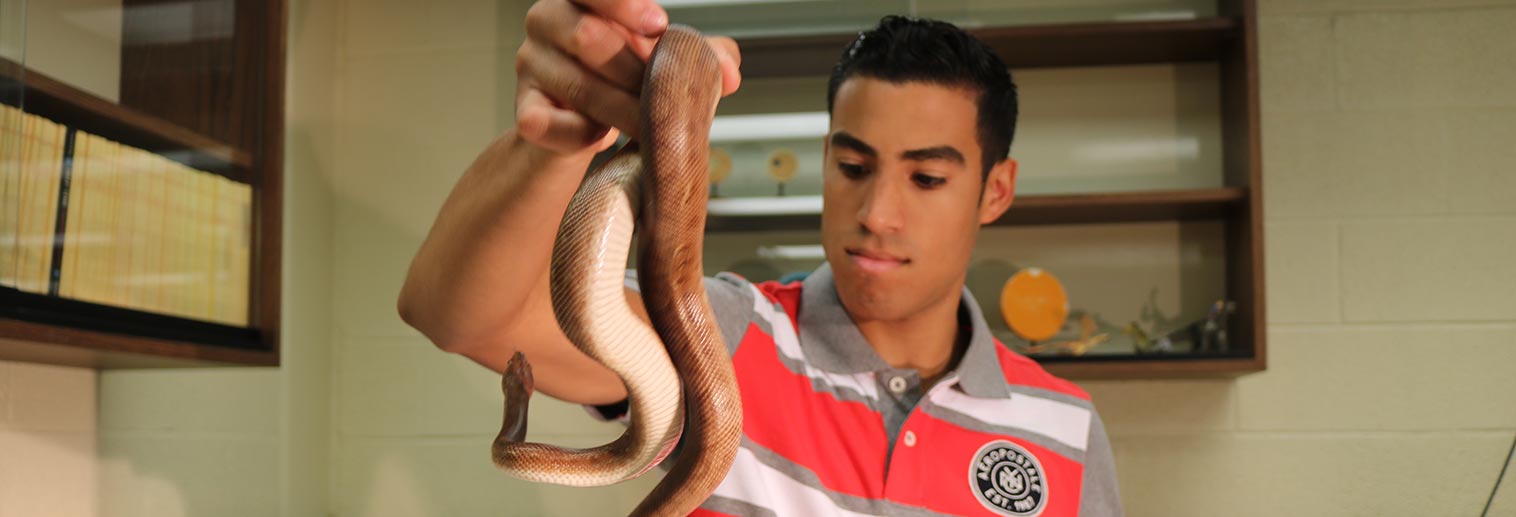Raymond Morales '17
“Extreme Kinesis: A Comparative Study of Prey Handling in Snakes”
Minor/Major: Biology
Hometown: Bethlehem, PA
Project Advisor: Dr. Irish
Briefly describe your project.
My project involved conducting research on snakes. The snake skull is kinetic, with upper jaws and snout suspended from the braincase by ligaments and muscles. Cranial kinesis allows snakes to swallow large prey whole. We studied rotation of the snout around a longitudinal axis through the nasofrontal joint during swallowing. Recordings of booid snakes during the strike and swallowing were collected using a high-speed camera at 500 frames per second (fps) and a high-definition camera at 60 fps.
The program Tracker was used to measure the angle of snout twisting and snout elevation. Results were analyzed using one-way analysis of variance to compare snout twisting from different species and determine if they are significantly different. The data collected showed three species Boa constrictor, Candoia aspera, Epicrates maurus all significantly different when compared to each other in snout twisting (p-value of 0.001). Further data is needed to understand the snout mobility during swallowing in all the different types of booids. To answer the question if Boa constrictors have extreme snout mobility and if sand boas truly have limited snout mobility?
Why did you decide to turn your idea into a SOAR project?
This study was based on the current research of Dr. Irish; in which the morphology of the different snake species is studied specifically on their ability to use snout mobility while swallowing prey whole.
How did your faculty advisor guide you through your research?
One of the best parts about working with my mentor Dr. Irish was being able to work with her on finding different aspects of biological research. She provided me with a great insight into what the field of scientific research is all about. Apart from the research, I shared many laughs with my mentor and cultivated a great relationship as well.
What has been your biggest obstacle so far?
During the study, the biggest obstacle was collecting different points of views of the feeding mechanism for the snake species we were studying. This required us to have to make a continual recording of the same species until we reached recordable data.
What has been your biggest takeaway from this experience?
One of the biggest takeaways for me was learning what a possible career in research would look like. What the daily disciples and qualities are required for this type of profession. I could also see the passion my mentor had for her research and the genuine love for what she practiced. Whatever profession you choose to do; do it passionately.
What was the result of your project?
We were able to identify the snout motilities for a couple new snake species that have not been studied before and we formed new hypotheses for why certain snakes might have more or less snout mobility that can be pursued in future studies.
Will you expand on your research after this summer is over? If so, where would you like to see it go?
At this point, I will not continue to take part in this continual research study, but one of my fellow peers will continue the study in the spring; during which she will continue to add to the study.
In your own words, how do you feel about being awarded this opportunity?
I felt extremely honored to be accepted into the SOAR program. Being part of an undergraduate research was an opportunity I did not know was offered at Moravian University. When I was presented with the opportunity I knew it would be an extremely rewarding one. I would recommend this opportunity to any student looking to better expand their learning experience in their field of study.

